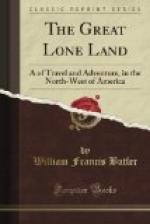The party, three in number, went to the fort, and knocked at the gate for admittance. The man on watch at the gate, before unharring, looked from the bastion over the stockades, to see who might be the three men who sought an entrance. It was bright moonlight, and he noticed the shimmer of a gun-barrel under the blanket of Tahakooch. The Sircies were provided with some dried meat, and the party went away. The Sircies marched first in single file, then followed Tahakooch close behind them; the three formed one line. Suddenly, Tahakooch drew from beneath his blanket a short double-barrelled gun, and discharged both barrels into the back of the nearest Sircie. The bullets passed through one man into the body of the other, killing the nearest one instantly. The leading Sircie, though desperately wounded, ran fleetly along the moonlit path until, faint and bleeding, he fell. Tahakooch was close behind; but the villain’s hand shook, and four times his shots missed the wounded wretch upon the ground. Summoning up all his strength, the Sircie sprung upon his assailant; a hand-to-hand struggle ensued; but the desperate wound was too much for him, he grew faint in his efforts, and the villain Tahakooch passed his knife into his victim’s body. All this took place in the same year during which I reached Edmonton, and within sight of the walls of the fort. Tahakooch lived only a short distance away, and was a daily visitor at the fort.
But to recount the deeds of blood enacted around the wooden walls of Edmonton Would be to fill a volume. Edmonton and Fort Pitt both stand within the war country of the Crees and Blackfeet, and are consequently the scenes of many conflicts between these fierce and implacable enemies. Hitherto my route has led through the Cree country, hitherto we have seen only the prairies and woods through which the Crees hunt and camp; but my wanderings are yet far from their end. To the south-west, for many and many a mile, lie the wide regions of the Blackfeet and the mountain Assineboines; and into these regions I am about to push my way. It is a wild, lone land guarded by the giant peaks of mountains whose snow-capped summits lift themselves 17,000 feet above the sea level. It is the birth-place of waters which seek in four mighty streams the four distant oceans—the Polar Sea, the Atlantic, the Gulf of Mexico, and the Pacific.
A few miles north-west of Edmonton a settlement composed exclusively of French half-breeds is situated on the shores of a rather extensive lake which bears the name of the Grand Lac, or St. Albert. This settlement is presided over by a mission of French Roman Catholic clergymen of the order of Oblates, headed by a bishop of the same order and nationality. It is a curious contrast to find in this distant and strange land men of culture and high mental excellence devoting their lives to the task of civilizing the wild Indians of the forest and the prairie—going far in advance of the settler, whose advent they have but




